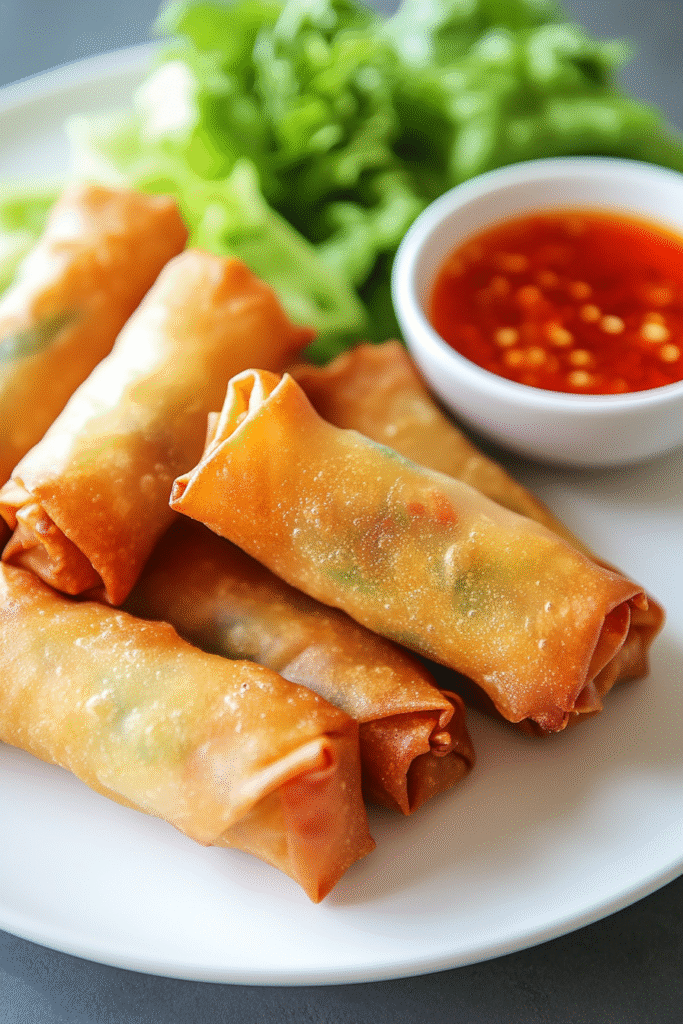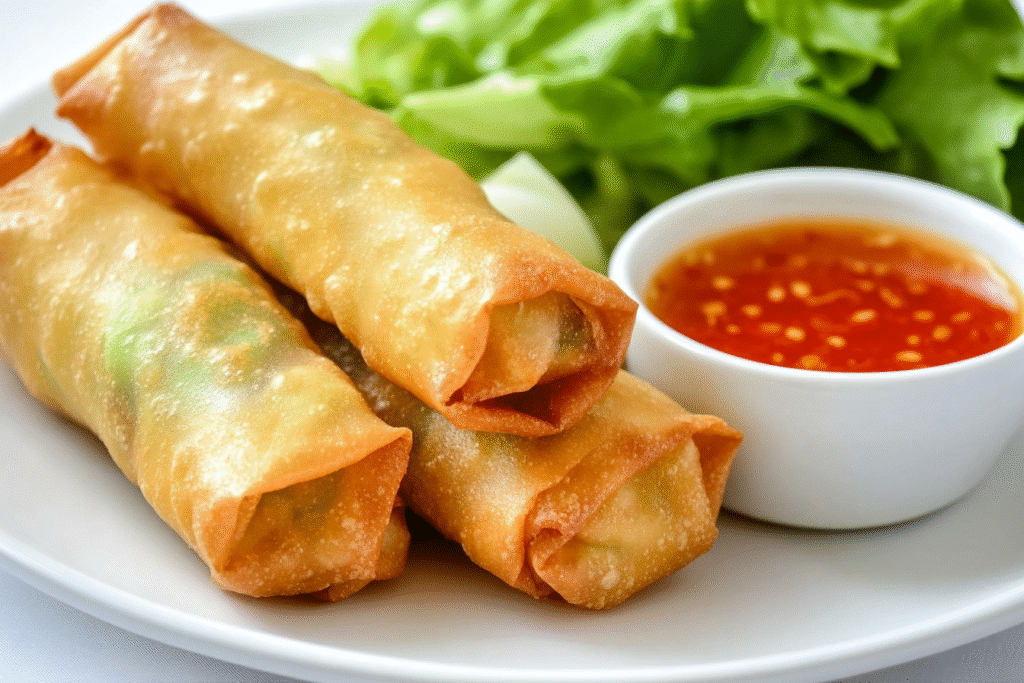The Universal Appeal of Vegetable Spring Rolls
Vegetable Spring Rolls are a beloved appetizer and snack in many Asian cuisines, prized for their ultra-crispy shells and flavorful, tender-crisp vegetable fillings. When done right, they offer the perfect balance: a crackling bite that gives way to a fresh, savory, and lightly seasoned interior. Unlike heavier meat-filled spring rolls, vegetable versions are lighter, fresher, and incredibly versatile—delicious as a starter, part of a party platter, or even as a light lunch with dipping sauces.
While spring rolls are often deep-fried, this recipe focuses on a home-friendly version that can be either fried, oven-baked, or air-fried without compromising the signature crunch. The key to the best vegetable spring rolls is preparing a filling that is vibrant and flavorful, with just enough moisture to stay tender but not so much that it risks making the wrapper soggy.
Once you’ve mastered the basic rolling technique, you’ll find these spring rolls easy to assemble and perfect for making in large batches. They freeze beautifully and can be cooked straight from frozen, making them an excellent prep-ahead option.
Selecting the Best Vegetables for Spring Rolls
Classic Vegetable Fillings:
- Cabbage: Shredded and lightly sautéed, cabbage adds volume and sweetness.
- Carrots: Julienned for crunch and color.
- Bean Sprouts: Add texture and freshness.
- Bell Peppers: Provide a sweet bite and vibrant color.
- Spring Onions: Bring a mild onion flavor.
- Glass Noodles (Optional): Soaked vermicelli noodles are often added for texture and to absorb flavor.

Additional Options:
- Mushrooms, bamboo shoots, baby corn, or water chestnuts can also be included for variety.
Important Tip:
The filling should be sautéed briefly to remove excess moisture, which helps prevent soggy rolls.
Recommended Equipment for Crisp Spring Rolls
- Large Skillet or Wok: For sautéing the vegetable filling quickly over high heat.
- Slotted Spoon: Useful for draining moisture from the filling.
- Pastry Brush: If baking, a light brushing of oil helps the wrappers crisp.
- Deep Fryer or Large Pan: For deep-frying if desired.
- Tongs: Essential for flipping and removing spring rolls during cooking.

Common Mistakes and How to Avoid Them
1. Overfilling the Rolls
Too much filling makes the spring rolls difficult to seal and prone to bursting during cooking.
2. Not Cooking the Filling Properly
Raw vegetables release too much moisture when cooking. Lightly sautéing and cooling the filling prevents soggy rolls.
3. Wrapping Too Loosely
Loose wrapping traps air and can lead to soggy or ruptured rolls. Tightly roll and seal the edges to maintain structure.
4. Cooking at the Wrong Temperature
If frying, oil that’s too cool will produce greasy rolls; oil that’s too hot may burn the wrapper before the interior heats through. Aim for 350–375°F (175–190°C).
Ingredient Swaps and Dietary Adjustments
- Gluten-Free: Use gluten-free spring roll wrappers or rice paper (results in a different texture).
- Vegan: Naturally vegan as written—just ensure your wrappers are egg-free.
- Spice Variations: Add sriracha, chili flakes, or finely chopped chilies to the filling for a spicy kick.
Prep-Ahead and Time-Saving Tips
- Make in Advance: Fill and roll spring rolls up to 24 hours ahead and refrigerate covered with a damp cloth.
- Freeze Uncooked Rolls: Freeze on a tray, then transfer to bags. Cook directly from frozen, adding a few extra minutes.
- Pre-Chop Vegetables: Chop and prep the filling the day before to save time.
Flavor Boosters and Pairing Ideas
- Add Garlic and Ginger: For aromatic depth.
- Soy Sauce and Sesame Oil: Enhance the filling’s umami and fragrance.
- Dipping Sauces: Sweet chili sauce, soy sauce, hoisin, or peanut sauce pair beautifully.
Pair With:
- Asian-style salads
- Steamed dumplings
- Rice or noodle dishes
Vegetable Spring Rolls Recipe
Ingredients
For the Filling
- 2 cups cabbage, finely shredded
- 1 large carrot, julienned
- 1/2 red bell pepper, thinly sliced
- 1/2 cup bean sprouts
- 2 spring onions, finely chopped
- 1 tablespoon soy sauce
- 1 teaspoon sesame oil
- 1 teaspoon garlic, minced
- 1 teaspoon ginger, grated
- Salt and pepper, to taste
- 1 tablespoon vegetable oil for sautéing
For the Rolls
- 12 spring roll wrappers
- 1 tablespoon flour mixed with 2 tablespoons water (sealing paste)
- Vegetable oil for frying or brushing
Instructions
Step 1: Prepare the Filling
- Heat 1 tablespoon of vegetable oil in a large skillet or wok over medium-high heat.
- Add garlic and ginger, sauté for 30 seconds until fragrant.
- Stir in cabbage, carrot, and bell pepper. Cook for 3–4 minutes until just softened.
- Add bean sprouts, spring onions, soy sauce, sesame oil, salt, and pepper.
- Cook for another 1–2 minutes, then remove from heat.
- Allow the filling to cool completely.
Step 2: Assemble the Spring Rolls
- Place a wrapper on a flat surface with one corner facing you (like a diamond).
- Add 2–3 tablespoons of filling near the corner closest to you.
- Fold the corner over the filling, roll tightly halfway, then fold in the sides.
- Continue rolling and seal the edge with the flour-water paste.
- Repeat with remaining wrappers and filling.
Step 3: Cooking Methods
For Deep-Frying:
- Heat oil in a deep pan to 350°F (175°C).
- Fry spring rolls in batches for 3–4 minutes, turning until golden and crispy.
- Drain on paper towels.
For Baking:
- Preheat oven to 220°C (425°F).
- Place rolls on a baking sheet lined with parchment paper.
- Lightly brush or spray with vegetable oil.
- Bake for 20–25 minutes, turning halfway, until crisp and golden.
For Air-Frying:
- Preheat air fryer to 200°C (400°F).
- Place rolls in a single layer and air fry for 10–12 minutes, turning halfway, until crispy.
Step 4: Serve
- Serve hot with sweet chili sauce, soy dipping sauce, or hoisin.
Storage and Reheating
- Refrigerator: Store uncooked rolls for up to 24 hours, covered with a damp cloth.
- Freezer: Freeze uncooked spring rolls for up to 2 months. Cook from frozen without thawing.
- Reheating: Reheat cooked rolls in the oven or air fryer to regain crispness. Avoid microwaving as it softens the wrapper.
Troubleshooting Tips
- Spring Rolls Splitting? Likely from overfilling or improper sealing. Use a small amount of filling and ensure tight wrapping.
- Not Crispy Enough? Ensure enough oil is used for frying, or spray generously with oil when baking or air frying.
- Soggy Rolls? The filling may have been too wet—ensure vegetables are cooked briefly and excess moisture is drained.
Variations: Classic vs. Creative Spring Rolls
- Classic Vegetable: Cabbage, carrots, bean sprouts, and simple seasoning.
- Noodle-Filled: Add cooked vermicelli for extra body.
- Spicy: Add chili sauce or fresh chilies to the filling.
- Fusion: Try adding feta cheese, sun-dried tomatoes, or spiced chickpeas for a twist.
Each variation offers a different flavor profile but keeps the satisfying crunch that defines a great spring roll.
Serving Suggestions
- Dipping Sauces: Sweet chili sauce, soy sauce with rice vinegar, peanut dipping sauce, or hoisin sauce.
- Sides: Asian slaw, steamed dumplings, or cucumber salad.
- Party Platters: Combine with samosas, bao buns, or crispy prawns for a mixed appetizer spread.
For drinks, pair vegetable spring rolls with jasmine tea, sparkling water with lime, or a light lager to complement the crispy texture and savory flavors.


